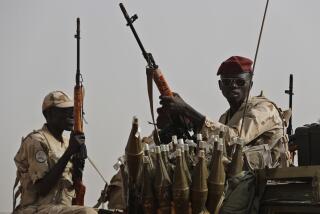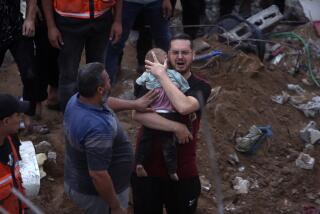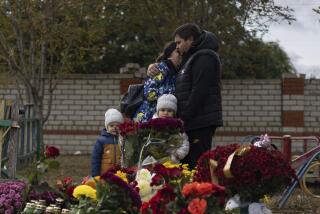U.N. team visits Syria site of reported massacre
ANTAKYA, Turkey — United Nations observers visited an alleged massacre site in Syria on Saturday but reached no conclusion about whether the killings were a deliberate slaughter of civilians or the result of clashes between government troops and insurgents.
After entering the central village of Treimseh, the U.N. team also offered no estimate on casualties. Opposition activists say that as many as 200 people were killed.
But the U.N. team did conclude that “an attack,” apparently by government forces, “appeared targeted at specific groups and houses, mainly of army defectors and activists,” according to the preliminary report. “There were pools of blood and blood spatters in rooms of several homes, together with bullet cases.”
The monitors found that a wide range of weapons were used, including artillery, mortars and small arms. Observers saw a burned school and damaged houses “with signs of internal burning in five of them.”
But the initial report did nothing to clarify two sharply divergent versions: Opposition activists say a massacre by security forces, while the Syrian government says its forces expelled “terrorists” — its customary label for insurgents — who had held the town hostage.
The incident in Treimseh is the latest reported massacre in which both sides disputed how the killings occurred. The Syrian government has greatly restricted the entry of independent journalists and human rights monitors, making it difficult to ascertain the truth in such cases.
The government has accused the rebels of staging massacres and then trying to pin the blame on the security forces in a bid to turn world opinion against Syrian President Bashar Assad. Rebels have said that Syrian forces have engaged in sectarian-tinged mass killings as a deliberate tactic to terrorize the opposition and stoke communal hatred.
The U.N. monitoring team has provided some clues in several earlier cases of mass killings, notably the slaying of more than 100 people in late May in the town of Houla, which, like Treimseh, lies in central Hama province. In that case, however, the observers arrived while the victims’ bodies were still present and were able to confirm that most of the dead were women and children.
That apparently was not the case in Treimseh, where the initial U.N. report makes no mention of bodies; remains may already have been buried.
A spokesman for the Britain-based Syrian Observatory for Human Rights, an opposition group, said the dead in Treimseh included “dozens of martyrs … from the rebellious fighting brigades,” a reference to insurgents. The dead also included 17 women, children and elderly, the group said, along with 30 burned bodies that could not be identified. The group’s information could not be independently verified.
But the substantial reported casualty count among insurgents suggests that the town may have been under rebel occupation when attacked, prompting a fierce battle for control.
At the other end of the information spectrum, official Syrian television reported that “terrorists” at the scene had been ordered to commit a massacre so that the Syrian military would be accused of the atrocity. Pro-government news media also reported that a Turkish officer had been commanding “terrorists” at the scene. Syria has called the rebellion a foreign-based conspiracy.
The U.N. decision to enter Treimseh was noteworthy, because the observation team has been largely grounded for a month for safety reasons. U.N. observers plan to return to the town Sunday.
Marrouch is a special correspondent.
More to Read
Sign up for Essential California
The most important California stories and recommendations in your inbox every morning.
You may occasionally receive promotional content from the Los Angeles Times.










